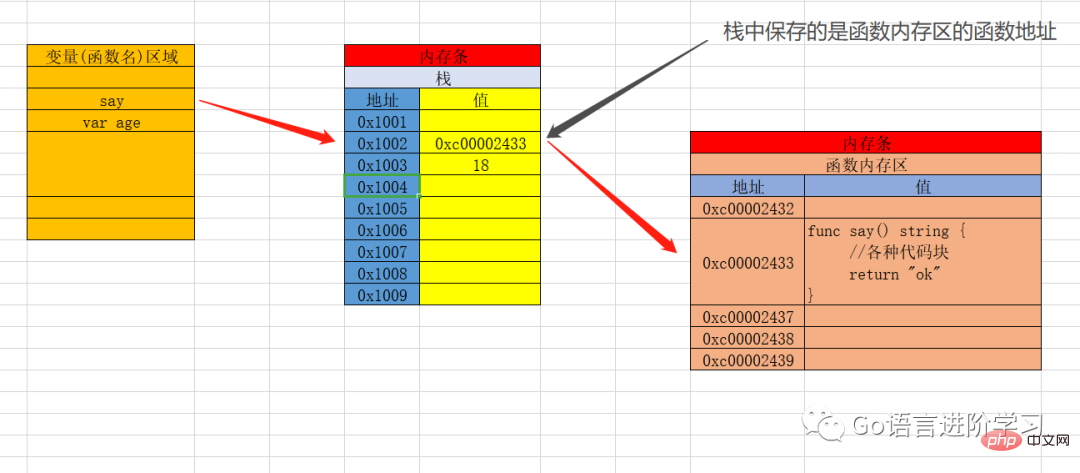
We know from the above that when defining a function, the function memory allocation can be understood as follows.

At the same time, we also know that no matter what operation is performed, it will only operate thestackThe aboveis worth.
I don’t know if you have ever thought about defining a variable and receiving a function, just like this.
package main import "fmt" func say() { fmt.Println("say") } func main() { var s1 = say s1() }
The execution results are as follows.

It can be found that through avariablereceives aFunction name, there is no problem when executing it throughvariable name brackets.
So, what type is this variable? ? ?
fmt.Printf("%T\n",s1)
执行结果

如果我将say函数改一下呢?
func say(s int) int{ fmt.Println("say") return 1 }
fmt.Printf("%T\n",s1)

可以发现,如果函数参数和返回值不一样,打印出来的类型也是不一样的。
上述我们知道,可以通过变量接收一个函数名。
通过变量接收函数名是没有约束的,不管函数几个参数,几个返回值,都可以接收,真是活出了动态语言的样子。
而定义函数类型就是限制变量接收函数,只能接收指定格式的函数。
主要用到type关键字。
格式
type 变量名 func([参数类型,参数类型]) [返回值类型] 中括号表示可选参数
例如
type a func() type b func(int) type a func(int,int) int
具体代码
package main import "fmt" /* 定义一个函数类型的变量 接收的函数参数必须是两个int类型 函数的返回值也必须是int类型 */ type cType func(int, int) int func say1(a, b int) int { fmt.Println("say",a+b) return 1 } func say2(a, b int) { fmt.Println("say") } func main() { var s1 cType s1 = say1//调用s1其实调用的就是say1 s1(1,1) //var s2 cType //s2 = say2//报错,cannot use say2 (type func(int, int)) as type cType in assignment }
千万不要被这个名字唬住了。
简单点说,高阶函数就是把函数当作参数或者把函数当作返回值。
package main import "fmt" func add(x int, y int) int { return x + y } func calc(x int, y int, other func(int, int) int) int { return other(x, y) } func main() { //将add函数传入第三个参数 var result = calc(34, 12, add) fmt.Println(result) }
package main import "fmt" func add(x int, y int) int { return x + y } func test() (func(int, int) int) { return add } func main() { var a = test() fmt.Println(a(1,2)) }
至于上述两个的功能,恕小生不才,至今用到的场景不多。
匿名函数顾名思义,就是没有名字的函数。
语法如下
func([参数,参数...])[(返回值,返回值)]{ 代码 }() //匿名函数后面必须跟括号,直接执行
例如
func() { }() func(x int, y int) (int) { return x + y }()
代码
package main import "fmt" func main() { //s1等于一个匿名函数,并且直接执行 var s1 = func(x int, y int) (int) { return x + y }(1,2) fmt.Println(s1) }
闭包,这个有点不太理解,简单点说就是函数里面套了一个函数,里面函数引用的外面函数的变量。
示例
package main import "fmt" func other() func() { //返回的是一个函数类型 var a = 666 return func() { //内部函数使用的是外面函数的a fmt.Println(a) } } func main() { var o = other() o() }
执行结果。

结果是没有问题的。
虽然我们以前学过,函数执行完毕后,里面的变量会回收。
But when using closures, it can be understood that if the inner function uses the variable of the outer function, then the variable will not be recycled.
This article mainly talks aboutFunctions and variables,Higher-order functions,Anonymous functions,Closure,Among them, closure is more difficult to understand, so you must spend some time on it. The edge of a sword comes from sharpening, and the fragrance of plum blossoms comes from the bitter cold. You must practice more.
The above is the detailed content of An article to help you understand the basic functions of Go language (Part 2). For more information, please follow other related articles on the PHP Chinese website!
 Usage of Type keyword in Go
Usage of Type keyword in Go How to implement linked list in go
How to implement linked list in go What are the Go language programming software?
What are the Go language programming software? How to learn go language from 0 basics
How to learn go language from 0 basics What are the methods to implement operator overloading in Go language?
What are the methods to implement operator overloading in Go language? What are the operators in Go language?
What are the operators in Go language? How to turn off real-time protection in Windows Security Center
How to turn off real-time protection in Windows Security Center oracle add trigger method
oracle add trigger method